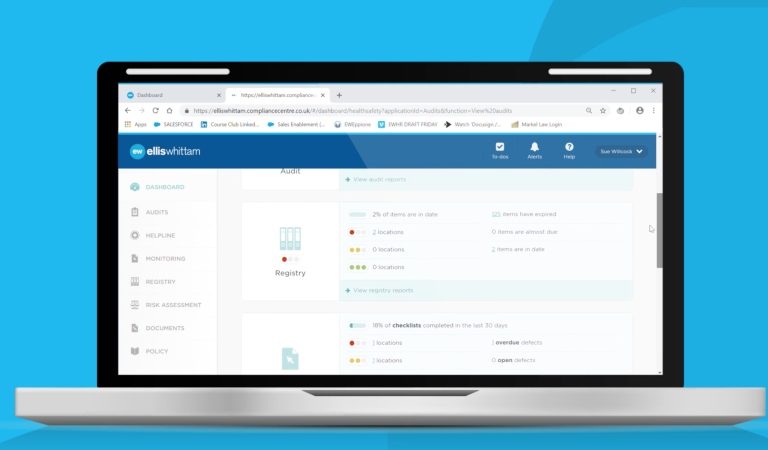Health & Safety
Your Health & Safety Handbook should be the go-to safety document for your team.
It should act as a synopsis of your Health & Safety Policy, outlining all the necessary information your employees need to carry out their role safely, reducing risk to themselves and others.
Ultimately, making sure that employees understand your health and safety rules and procedures will provide a firm basis for health and safety management, thereby ensuring you are compliant and reducing financial and reputational risk.
So where do you start when it comes to creating a Health & Safety Handbook for employees? And why does your business need one? Here’s everything you need to know.
Get your FREE consultation
Submit your details and one of our team will be in touch.
How we help
Why do I need a Health & Safety Handbook?
In order for you to meet your legal duties under health and safety legislation, employees must meet theirs.
Often, employers assume that they are solely responsible for ensuring their workplace is safe and compliant. However, Section 7 of the Health and Safety at Work Act 1974 places a legal duty on employers to:
- Co-operate with management in all matters concerning the health, safety and welfare.
- Take reasonable care their own health, safety and welfare, as well as that of any other person who may be affected by their acts or omissions whilst at work.
Your Health & Safety Handbook will help to make these duties clear and ensure that everyone within your organisation understands the role they play in creating a healthy and safe working environment. It will explain to employees what is expected of them, and help them to fulfil their Section 7 duties by providing information on safe working practices and what to do should an incident occur.
Related Information


BLOG
HSE Injury and Ill-Health Statistics 2020 | Some Improvements but Challenges Remain

Is it a legal requirement to have a Health & Safety Handbook?
As an employer, you have a duty to protect the health, safety and welfare of your employees and anyone else who might be affected by your activities. In doing so, you’re legally required to:
- Have a Health & Safety Policy that sets out your organisation’s health and safety objectives, responsibilities and arrangements;
- Ensure all employees are aware of and understand this policy; and
- Provide whatever information, instruction and training is needed to ensure, so far as is reasonably practicable, the health and safety of your employees.
While there is no specific legal requirement to have a Health & Safety Handbook, doing so will enable you to fulfil the legal duties set out above. It is an effective way of communicating your Health & Safety Policy to staff and provides fundamental health and safety information, including the important rules and procedures for employees to follow.
In this way, it will help you to demonstrate your commitment to health and safety and show that you have actively engaged employees in health and safety management.
What should a Health & Safety Handbook contain?
Your Health & Safety Handbook should help employees to understand how health and safety is managed in your workplace. It should therefore set out, in detail, employees’ duties and the general safety rules they must follow. You may also wish to include specific information about particular working practices and how specific tasks tasks should be carried out.
Depending on your business activities, your Health & Safety Handbook may include information on:
- General personal safety;
- Your accident or incident reporting procedures;
- Your first aid arrangements;
- Your fire and emergency procedures;
- Manual handling aids and techniques;
- The use of display screen equipment;
- Electrical safety;
- Storing and handling hazardous substances;
- Advice on work-related stress;
- Using personal protective equipment (PPE);
- Working at height;
- Your alcohol, drugs and smoking policy;
- Safe driving and use of mobile phones;
- Arrangements for vulnerable workers, such as young people or expectant mothers;
- The safe use of machinery and equipment; and
- Occupational health provisions.
Keep language clear and simple language to aid understanding.
Upon receipt of your Health & Safety Handbook, employees must make themselves familiar with its contents, and you should explain who they can contact if they are unclear about any aspects of the document so that the issue can be clarified.
It’s a good idea to get employees to sign a statement to show that they have read and understood your Health & Safety Handbook and accept the rules contained therein.
Your Health & Safety Handbook is a living document; you should encourage all employees to inform management of any areas of your Health & Safety Handbook or Health & Safety Policy that they feel are inadequate or misrepresented, or where practices and procedures have changed, to ensure they are maintained as valid working documents. Copies of any amendments should be circulated to all employees for inclusion with their handbook.
Policy v Handbook
It’s important to distinguish between a Health & Safety Policy and Health & Safety Handbook – though often combined, they are not the same.
Your Health & Safety Policy should set out your general approach and commitment to creating a healthy and safe working environment, together with the arrangements you have put in place for managing health and safety in your business. It is a unique document that states who does what, when and how. Your Health & Safety Handbook should make this information easily accessible to employees.
Current opinion is that policies should be short and refer to the handbook for more in-depth information on specific practices and procedures.
Who should write your Health & Safety Handbook?
You can put together your own handbook or have one created by an external health and safety company.
Importantly, under the Management of Health and Safety at Work Regulations 1999, employers must have access to support from competent persons – somebody with ‘sufficient training and experience or knowledge and other qualities’ – to help them to meet the requirements of health and safety legislation.
In other words, the person responsible for producing your Health & Safety Handbook should:
- Have had relevant training, such as a course accredited by IOSH;
- Have practical knowledge and experience of managing health and safety; and
- Have the appropriate skills and technical ability to develop solutions to problems.
Based on the level of expertise of our consultants, WorkNest will act as one of your legally required competent persons for all health and safety matters, and can expertly create a Health & Safety Policy and accompanying Health & Safety Handbook tailored to your organisation.
Looking for an expertly-crafted Health & Safety Handbook?
Handbooks are important – not least because they help communicate health and safety matters, which is essential to avoiding fines, enforcement and prosecution.
If you don’t feel sufficiently competent to create a Health & Safety Handbook yourself, WorkNest can put one for you as part of our unlimited, fixed-fee Health & Safety service. This gives you access to a dedicated Health & Safety Consultant with a wealth of hands-on experience, outstanding relevant qualifications and specific industry expertise. Your consultant will provide practical support with everything from preparing handbooks, policies and procedures to risk assessments and liaising with regulators.
For more information on how WorkNest can take the pressure off health and safety and elevate your current practices, call 0345 226 8393..
99.2% Client happiness rating
97% Client retention rating
Why choose us?
Experts in Health & Safety

We have the expertise to help you simplify complex health and safety legislation, find workable solutions to health and safety challenges, and protect your organisation from the rising cost of non-compliance.
- Approved by a Primary Authority
- Dedicated specialists with recognised qualifications
- Genuine hands-on experience of managing risk
- Cost certainty with our unlimited, fixed-fee model
- The confidence to act as one of your competent persons

Who you’ll be working with

Toyah Marshall
Principal Employment Law Adviser
Resources
Health & Safety Guides

How do I go about creating a Health & Safety Handbook?
As the purpose of producing a Health & Safety Handbook is to communicate your policies and procedures to employees, you should refer to your Health & Safety Policy as a starting point.
As a general structure, your Health & Safety Handbook should outline the potential health and safety hazards present in your workplace, explain the responsibilities placed on employees under Section 7 of the Health and Safety at Work Act etc 1974, and provide information on how specific tasks should be carried out.
Don’t have the time or expertise to produce this yourself? WorkNest can create a Health & Safety Policy tailored to your business.

What does Health & Safety Software actually do?
If you’re tired of managing health and safety manually, struggling to keep on top of what’s required, and unsure whether you’re compliant, then our award-winning Health & Safety Software might be the solution you’re looking for.
This easy-to-use dashboard allows you to manage all of your responsibilities in one place and get a clear picture of how you’re performing. Functions include monitoring and controlling the actions identified in your risk assessment, recording and investigating accidents and incidents, and the ability to view your risk status in real time monitoring. You can also replace reams of paperwork with an online filing cabinet of important documentation, and receive automatic alerts when your certificates and documents are due for renewal.

How often do I need to conduct a risk assessment?
It is not sufficient to conduct a risk assessment of your premises when starting out and simply assume everything is working fine from then on.
It is good practice to review your risk assessments at least annually to account for changes within your workplace. Risk assessments must also be reviewed after accidents or near misses occur (as this would suggest something isn’t working as it should), whenever new equipment or substances are introduced (as this could lead to new hazards), and when significant changes in personnel or working practices occur (as this may mean there are gaps in knowledge or responsibility).

What are the benefits of outsourcing health and safety management?
Getting to grips with the complexities of health and safety legislation can be a real demand on your time and resources. If you don’t have the time or expertise, it can feel like an impossible task.
Outsourcing your health and safety management to WorkNest takes the pressure off. Not only does our fixed-fee support offer a smart alternative to self-employed health and safety consultants who charge by the hour and a level of expertise that your in-house responsible person may lack, but we will even act as your legally-required competent person – giving you complete confidence in your compliance.

What does a Health & Safety Policy need to include?
Typically, a Health & Safety Policy is broken down into three areas:
- A Policy Statement of Intent, which details your health and safety aims and objectives, how you intend to manage health and safety issues, and your health and safety performance targets.
- The organisation of health and safety, which states the names, positions and duties of those within your organisation who have specific responsibility for health and safety.
- Arrangements for health and safety, which contains your health and safety rules and procedures, risk assessments, fire and emergency arrangements, and information on instruction, training and supervision.
See what specific information you need to cover

















